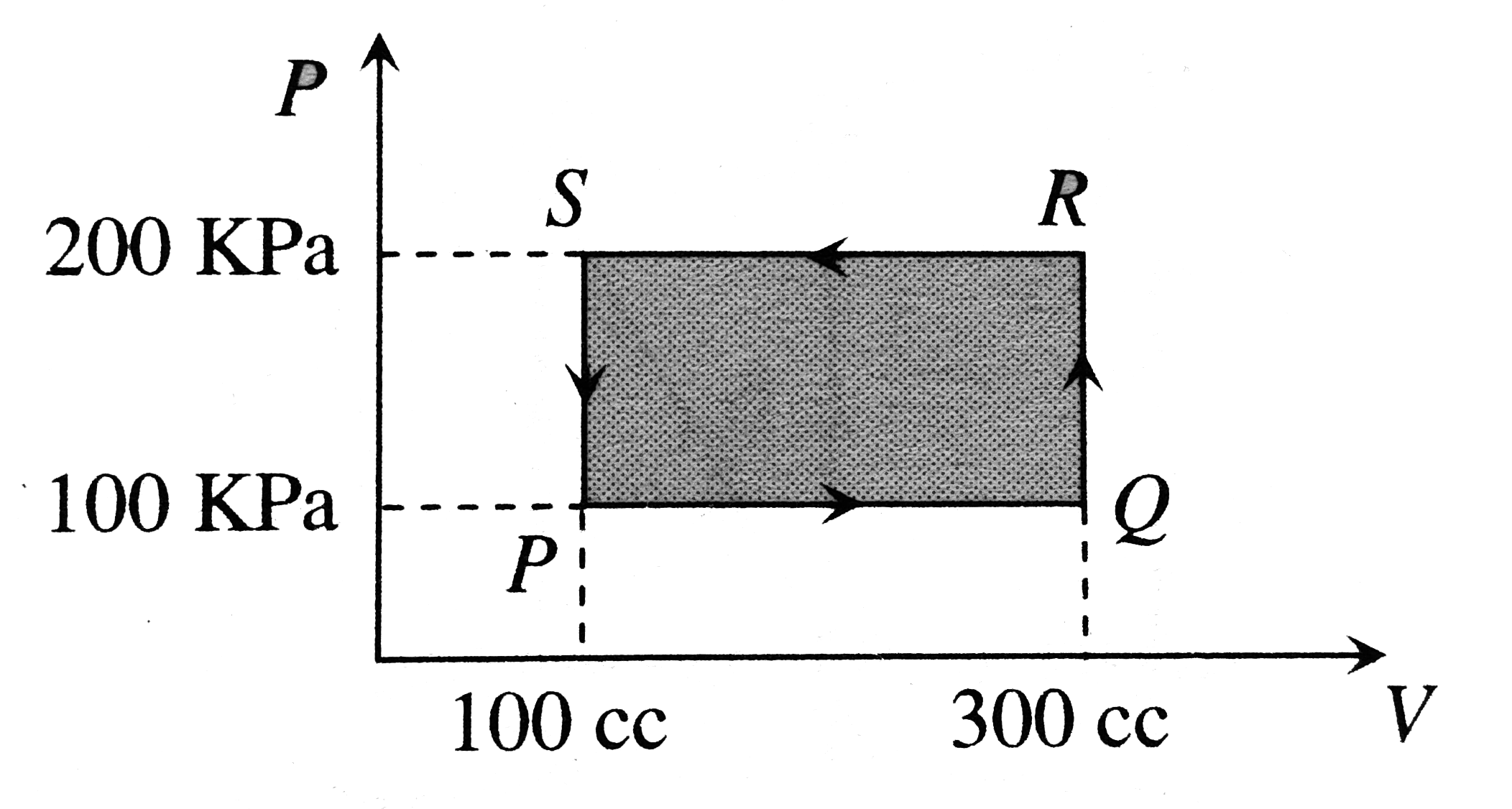In changing the state of a gas adiabatically from an equilibrium state A to another equilibrium state B, an amount of work equal to 22.3 J is done on the system. If the gas is taken from state A to B, via a process in which the net heat absorbed by the system is 9.35 cal, how much is the net work done by the system in the latter case ?
To solve the problem step by step, we will use the principles of thermodynamics, particularly the first law of thermodynamics, which states that the change in internal energy (ΔU) of a system is equal to the heat added to the system (Q) minus the work done by the system (W).
Step 1: Understand the adiabatic process
In the adiabatic process from state A to state B, the work done on the system is given as 22.3 J. Since it is an adiabatic process, there is no heat exchange (Q = 0). Therefore, the change in internal energy (ΔU) can be expressed as:
ΔU=−W=−(−22.3J)=22.3J
Step 2: Convert heat from calories to joules
In the second process where heat is absorbed, we are given that the net heat absorbed by the system is 9.35 cal. We need to convert this to joules using the conversion factor 1cal=4.18J:
Q=9.35cal×4.18J/cal=39.1J
Step 3: Apply the first law of thermodynamics
Now, we can apply the first law of thermodynamics for the second process:
ΔU=Q−W
We already calculated ΔU from the adiabatic process, which is 22.3 J. We can rearrange the equation to solve for the work done (W) in the second process:
W=Q−ΔU
Step 4: Substitute the values
Substituting the values we have:
W=39.1J−22.3J=16.8J
Step 5: Conclusion
Thus, the net work done by the system in the latter case is:
16.8J
---
In the adiabatic process from state A to state B, the work done on the system is given as 22.3 J. Since it is an adiabatic process, there is no heat exchange (Q = 0). Therefore, the change in internal energy (ΔU) can be expressed as:
ΔU=−W=−(−22.3J)=22.3J
In the second process where heat is absorbed, we are given that the net heat absorbed by the system is 9.35 cal. We need to convert this to joules using the conversion factor 1cal=4.18J:
Q=9.35cal×4.18J/cal=39.1J
Now, we can apply the first law of thermodynamics for the second process:
ΔU=Q−W
We already calculated ΔU from the adiabatic process, which is 22.3 J. We can rearrange the equation to solve for the work done (W) in the second process:
W=Q−ΔU
Substituting the values we have:
W=39.1J−22.3J=16.8J
Thus, the net work done by the system in the latter case is:
16.8J
Topper's Solved these Questions
- INTERNAL ENERGY BOOK - ICSECHAPTER - INTERNAL ENERGY EXERCISE - SELECTED PROBLEMS (FROM HEAT ENGINES)
21 Videos
- INTERNAL ENERGY BOOK - ICSECHAPTER - INTERNAL ENERGY EXERCISE - SELECTED PROBLEMS (FROM ISOTHERMAL AND ADIABATIC PROCESSES )
10 Videos
- GRAVITATIONBOOK - ICSECHAPTER - GRAVITATIONEXERCISE - FROM THE HUBBLE TELESCOP
2 Videos
- MOTION IN FLUIDS BOOK - ICSECHAPTER - MOTION IN FLUIDS EXERCISE - SELECTED PROBLEMS (FROM POISEUILLE.S FORMULA)
19 Videos
Similar Questions
In changing the state of a gas adiabatically from an equilibrium state A to another equilibrium state B, an amount of work equal to 22.3J is done on the system. If the gas is taken from State A to B via a process in which the net heat absorbed by the system is 9.35cal., How much is the net work done by the system in the later case? (Take 1cal.=4.9J)
View SolutionWhen a system is in equilibrium state
View Solution
Knowledge Check
In changing the state of a gas adiabatically from an equilibrium state A to another equilibrium state B an amount of work equal to 22.3 J is done on the system.If the gas is taken from state A to B via a process in which the net heat absorbed by the system is 9.35 cal then the net work done by the system in latter case is
(Take 1 case =4.2 J)A15 JB16 JC17 JD18 JWhen the state of a gas adiabatically changed from an equilibrium state A to another equilibrium state B an amount of work done on the stystem is 35 J. If the gas is taken from state A to B via process in which the net heat absorbed by the system is 12 cal, then the net work done by the system is (1 cal = 4.19 J)
Aa. 13.2JBb. 15.4 JCc. 12.6 JDd. 16.8 JAn ideal gas is taken through cycle A→B→C−A, as shown in Fig. IF the net heat supplied to the gas in the cycle is 5 J, the work done by the gas in the process C→A is
 A−5JB−10JC−15JD−20J
A−5JB−10JC−15JD−20J
Calculate the work done by the gas in the state diagram shown :

View SolutionA thermodynamic system is taken through the cyclic PQRSP process. The net work done by the system is

View SolutionA thermodynamic system is taken through the cyclic PQRSP process. The net work done by the system is

View SolutionFor a gaseous system find change in internal energy if the heat supplied to the system is 50 J and work done by the system is 16 J.
View SolutionFor a gaseous system find change in internal energy if the heat supplied to the system is 50 J and work done by the system is 16 J.
View Solution
